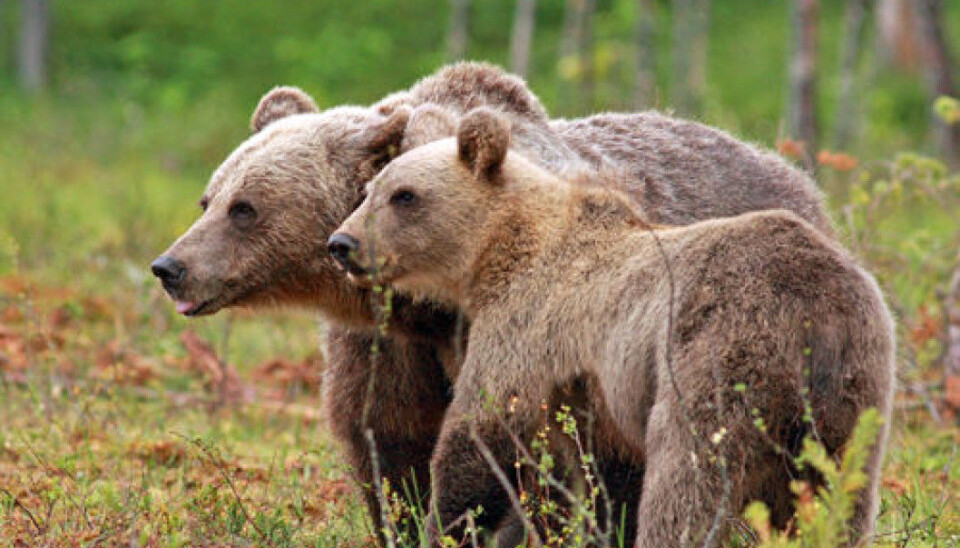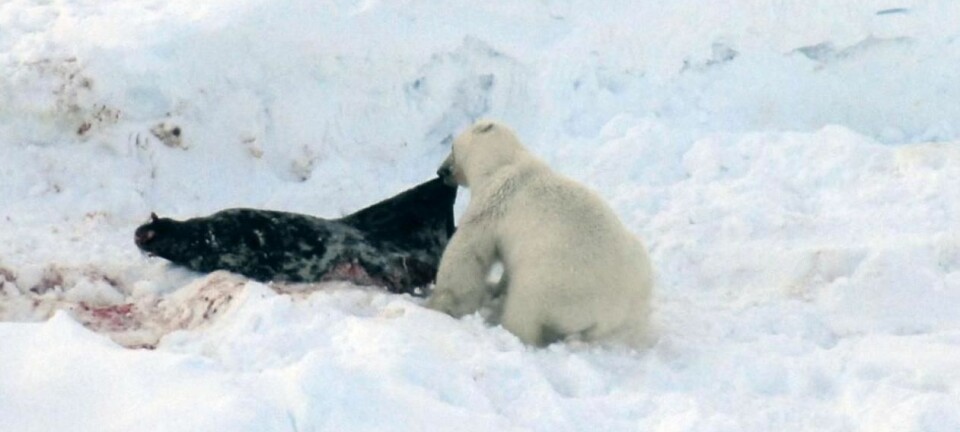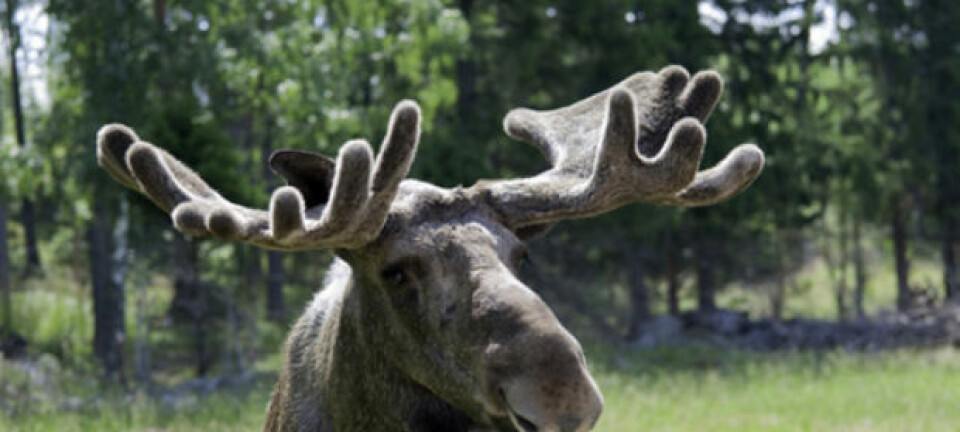
Solving the mystery of bear cub killings
Male bears in Scandinavian forests kill bear cubs. The corpses of cubs, claw marks and DNA samples testify to a life-or-death struggle.
Denne artikkelen er over ti år gammel og kan inneholde utdatert informasjon.
Swedish researchers studying bears arrive at the site of a horrific battle in a deep forest. Dead bear cubs and signs of a fight leave no doubt that a female and cubs-of-the-year have been attacked by a male.
“It’s not a pretty sight. Some of the students and volunteers helping in the research work are appalled. But we are happy to get the data,” says biologist Sam Steyaert.
Steyaert's study addresses infanticide, the killing of young offspring within a species, among brown bears. The project was a collaboration among the Institute of Wildlife Biology and Game Management at the University of Natural Resources and Life in Vienna, the Norwegian University of Life Sciences in Ås and Telemark University College.
The study is part of the Scandinavian Brown Bear Research Project, which has attracted scientists from several countries.
Partly eaten
When researchers find the corpses of bear cubs in the forest, they are sometimes partly eaten. This is just one of the indications that the female bear has defended her cubs fiercely.

“We see that trees are broken and there are claw marks on the trunk. You often find tufts of fur,” says Steyaert.
The researchers collect all the clues they can find, like CSI detectives on TV. They use these biological remains to identify the bears using DNA tests.
Different denouements
Sometimes a mother bear manages to escape with her cubs. In others, the entire brood or individual cubs are killed. In two cases, researchers observed that female bears were also killed. Females are smaller than adult male bears and not much of a match when it comes to brawls like these.
The researchers are able to find their horrific e evidence because many of the bears in their study area of Gävleborg and Dalarne in central Sweden have already been fitted with GPS transmitters and are monitored. This allows the scientists to follow their every move in detail.
When scientists see a female bear with cubs veering from her normal roaming pattern, or if they see that a male is in the same place at the same time, they begin to suspect there may have been a fight. Out in the woods they rely on a low-tech approach as well, finding the exact spot of the battle with the help of dogs.
The reason for this male bear aggression is under dispute. Researchers from the Scandinavian Brown Bear Research Project think the male’s motivation is primarily to mate with the female.
New studies are continually filling in the picture.
Hinders mating
Cubs are born in January or February. The cubs then follow their mother for one or two years. She will not mate as long as she is lactating and nursing them.
But she can come in heat again in just a few days once the cubs disappear. By killing the cubs the male is removing a hamper against successfully mating with the female.
Attacks on females with a brood are not uncommon in the Swedish bear territories of Gävleborg and Dalarna. Thirteen cases of infanticide have been registered in a three-year period.
“Nearly half of all female bears with GPS tags have been the victims of these kinds of attacks or attempts in the period they’ve been tracked,” says Steyaert.
Much remains unknown about the phenomenon. Steyaert stresses that it is a hard subject to study despite the space-age gadgets at hand. The technology fails now and then. The GPS collars can also simply fall off as the bears roam far and wide in rough terrain.
Avoiding males
The death of an entire brood of cubs is costly lost for a female. She has invested her time and resources into the cubs and will defend them with all her might.
One strategy females with cubs use is simply to shy away from areas where males might be. GPS tracking from an earlier study by the bear project showed that females with cubs stay away from areas of the forest where male bears and single females are found during the critical mating season.
In autumn, when the rutting and the oestrus period is over, the bears all roam in the same areas.
A new study by Steyaert and his colleagues published in the journal Biology Letters indicates that a mother bear’s strategy of avoiding trouble by using alternative areas during the mating period comes at a cost. These are areas where food supplies are poorer.
Sacrificing better foraging grounds
Bears eat a lot of grass and herbs at this time of year. The droppings of males as well as females with and without cubs have been analysed. These showed that mother bears had diets that had less protein and more fibre compared to the fare enjoyed by males and single females.
Once the mating season ends in the summer and the cubs are out of danger from aggressive males, the protein content in the droppings of these females improved.
The researchers see this as a smart strategy by the mother bears – they make a sacrifice by picking areas with slimmer pickings for part of the year when they and their offspring are vulnerable, compensating by eating better in the fall.
However, this study is based only on observations of a limited number of bears in just one season.
Avoidance
This kind of strategy is known from the relationship between animal predators and their prey. In periods where the prey are particularly at risk they prefer to withdraw to areas with a scantier food supply than to chance being eaten.
Mother bears with cubs also risk going closer to human habitats, houses and cabins, in the spring and summer.
“We think they use these areas as shields,” says Steyaert.
The bears are clever at hiding in these areas. In several cases the researchers have observed mothers with cubs less than 1,200 metres from human habitats. None of the locals were aware of their proximity.
Mainly Sweden
Sweden has more brown bears in total and greater density in its forests than neighbouring Norway – there are only about 160 brown bears in Norway versus upwards of 3,000 in Sweden.
Nevertheless, these are all the same stock and have common behaviour patterns on either side of the border.
Much remains a mystery about the male bears’ infanticidal conduct. There would be no genetic advantage in killing cubs they have sired. Researchers think males generally avoid doing so. But if this is true, how do the males know which cubs are their own offspring?
Males that wander into a new area are not likely to be the father of any cubs they encounter, and these newcomers are often the most aggressive bears.
It hasn’t been proved, but males might also be capable of registering by scent whether cubs are their own offspring.
Translated by: Glenn Ostling
Scientific links
- S. M. J. G. Steyaert, C. Reusch, S. Brunberg, J. E. Swenson, K. Hackländer og A. Zedrosser: “Infanticide as a male reproductive strategy has a nutritive risk effect in brown bears,” Biology Letters 2. october 2013.
- S. M. J. G. Steyaert, J. Kindberg, J. E. Swenson og A. Zedrosser: ”Male reproductive strategy explains spatiotemporal segregation in brown bears,” Journal of Animal Ecology, 5. march 2013.
































